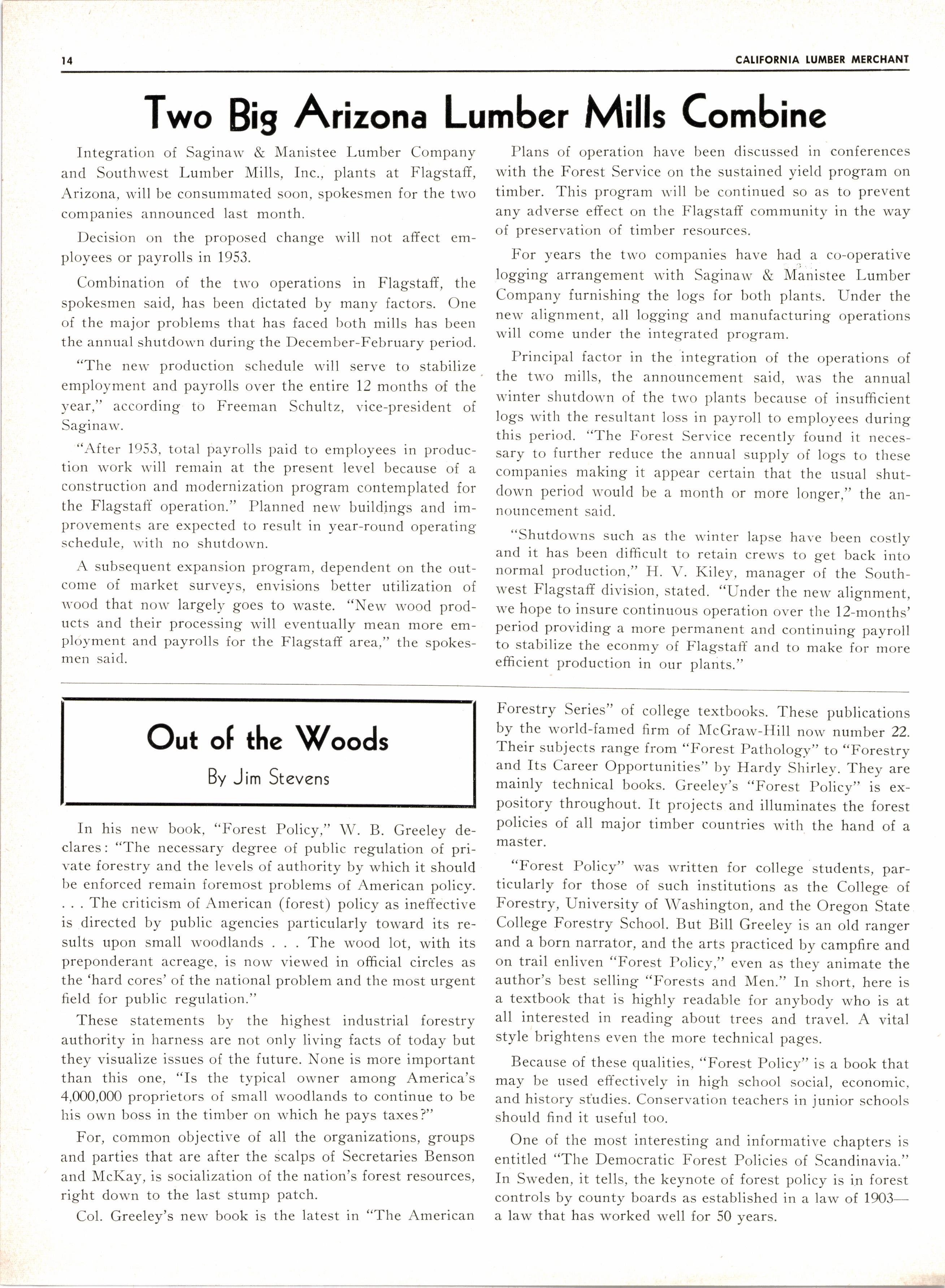
3 minute read
Two Big Arizona Lumber Mills Combine
Integration of Saginarv & Manistee Lumber Company and Southrvest Lumber Mills, Inc., plants at Flagstaff, Arizona, n'ill be consummated soon, spokesmen for the trvo companies announced last month.
Decision on the proposed change will not affect employees or payrolls in 1953.
Combination of the tn.o operations in Flagstaff, the spokesmen said, has been dictated by many factors. One of the major problems that has faced both mills has been the annual shutdorvn during the December-February period.
"The nerv production schedule .ivil1 serve to stabilize employment and payrolls over the entire 12 months of the 1'ear," according to Freeman Schultz, vice-president of Saginarv.
"After 1953, total payrolls paid to employees in production rvork rvill remain at the present level because of a construction and modernization program contemplated for the Flagstait operation." Planned nerv buildings and improrrements are expected to result in year-round operating schedule, rrith no shutdo.rvn.
A subsequent expansion program, dependent on the outcome of market surveys, envisions better utilization of t'ood that nou' largeh. goes to waste. "New rvood products and their processing will eventually mean more employment and payrolls for the Flagstaff area," the spokesmerr said.
Out o[ the \(/oods
Bv Jir Stevens
In his new book, "Forest Policy," W. B. Greeley declares: "The necessary degree of public regulation of private forestry and the levels of authority by which it should be enforced remain foremost problems of American policy.
The criticism of American (forest) policy as ineffective is directed by public agencies particularly toward its results upon small 'ivoodlands . The wood lot, with its preponderant acreage. is now viewed in official circles as the 'hard cores' of the national problem and the most urgent field for public regulation."
These statements by the highest industrial forestry authority in harness are not only living facts of today but they visualize issues of the future. None is more important than this one, "Is tl-re typical owner among America's 4,000,000 proprietors of small woodlands to continue to be his own boss in the timber on which he pays taxes?"
For, common objective of all the organizations, groups and parties that are after the scalps of Secretaries Benson and McKay, is socialization of the nation's forest resources, right down to the last stump patch.
Col. Greeley's nerv book is the latest in "The American
Plans of operation have been discussed in conferences with the Forest Service on the sustained yield program on timber. This program u'ill be continued so as to prevent any adverse efi[ect on the Flagstaff community in the wav of preservation of timber resources.
For years the trn'o companies have had a c<,1-operative logging arrangement u'ith Saginarv & Manistee Lumber Company furnishing the logs for both plants. Under the neu' alignment, all logging and manufacturing operations will come under the integrated program.
Principal factor in the integration of the operations of the tu'o mills, the announcement said, rvas the annual u,inter shutdorvn of the trvo plants because of insufficient logs rvith the resultant loss in payroll to employees during this perio<l. "The Forest Service recently found it necessary to further reduce the annual supply of logs to these companies making it appear certain that the usual shutdown period u'ould be a month or more longer," the announcement said.
"Shutdorvns such as the u'inter lapse have been costly and it has been difficult to retain crews to get back into normal production," H. V. Kiley, manager of the South_ rvest Flagstaff division, stated. "Under the ner,v alignment, u'e hope to insure continuous operation over the l2-months' period providing a more permanent and continuing pavroll to stabilize the econmy of Flagstaff ancl to make for more efficient production in our plants."
Forestry Series" of college textbooks. These publications by the l,vorld-famed firm of N{cGrarv-Hill norv number 22. Their subjects range from "Forest pathology', to .,Forestry and Its Career Opportunities" by Hardy Sl-rirley. They are mainly technical books. Greeley's "Forest policy" is expository throughout. It projects and illuminates the forest policies of all major timber countries rvith the hand of a master.
"Forest Policy" was r,vritten for college students, particularly for those of such institutions as the College of Forestry, University of Washington, and the Oregon State College Forestry School. But Bill Greeley is an old ranger and a born narrator, and the arts practiced by campfire and on trail enliven "Forest Policy," even as tl-rey animate the author's best selling "Forests and Men." In short, here is a textbook that is highly readable for anybody who is at all interested in reading about trees and travel. A vital style brightens even the more technical pages.
Because of these qualities, "Forest Policy" is a book that may be used effectively in high school social, economic. and history studies. Conservation teachers in junior schools should find it useful too.
One of the most interesting and informative chapters is entitled "The Democratic Forest Policies of Scandinavia." In Sweden, it tells, the keynote of forest policy is in forest controls by county boards as established in a law of 1903a law that has worked well for 50 years.










